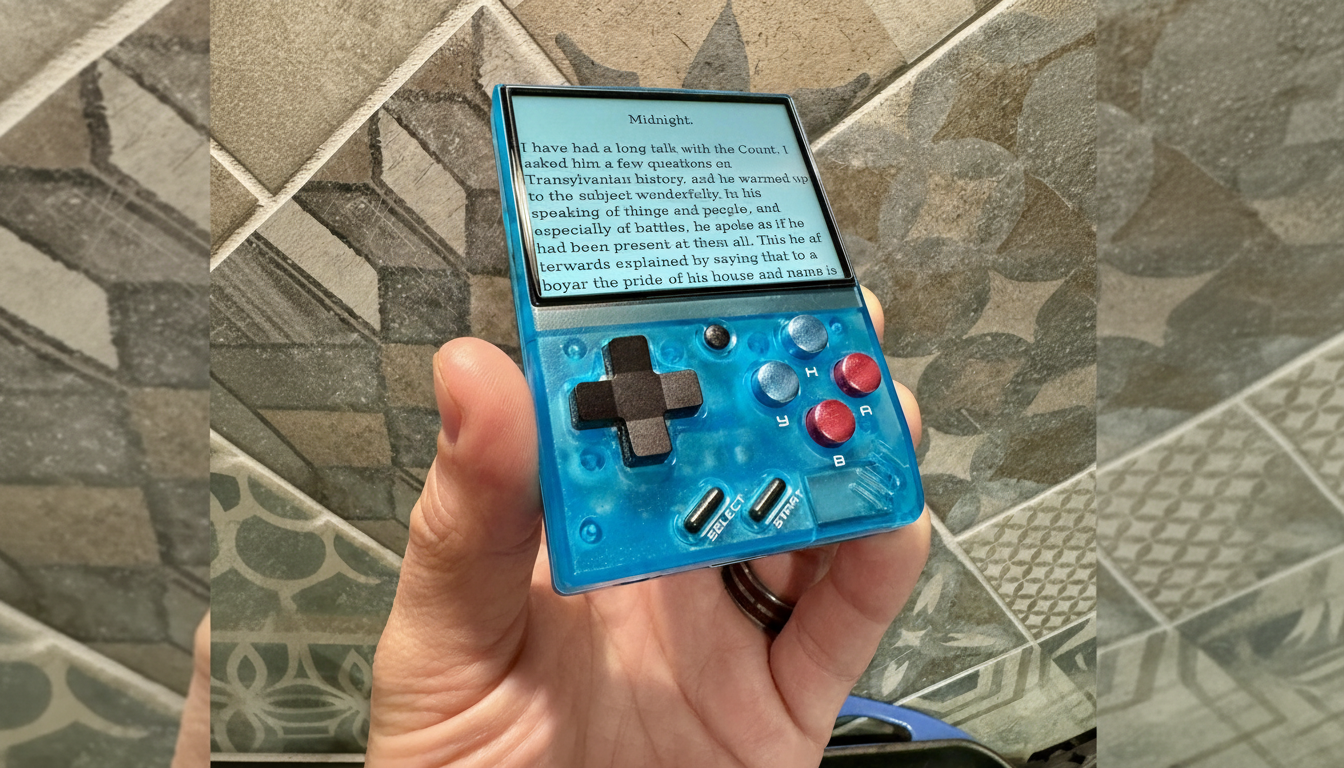I broke our no-gifts tradition to give my husband something oddly specific and quietly radical: a retro gaming handheld that you can play in 2019. Not a console that’s tethered to the TV, not another smartphone game with timers and loot boxes, but a handheld device designed to play the games we grew up with free of ads, nags or other interruptions.
I was taken aback not only by his response but how distinctly this addressed a modern challenge. It transformed disparate, ad-jammed micro-sessions on a phone into intentional, low-friction play that suits an adult timetable.
- Why an Emulation Handheld Made the Perfect Gift
- Choosing Hardware That Truly Fits a Busy Adult Life
- Understanding Setup Complexity and Emulation’s Legal Lines
- A Better Choice Than Today’s Modern Free-to-Play Games
- What Happened After the Gift Box Was Finally Opened
- Practical Advice for Gifting a Retro Emulation Handheld
- The Joy I Was Really Buying with This Simple Gift

Why an Emulation Handheld Made the Perfect Gift
My husband plays mobile games the way most people watch Twitter or Instagram feed—frequently and for short bursts, usually beholden to whatever ads or cooldown periods various titles are harnessing. That’s all by design; modern free-to-play titles are designed to optimize for retention, not satisfaction. We know that two-thirds of Americans play video games although the average gamer is 36, according to the Entertainment Software Association — but most of us are not playing in a way designed to bring joy. It’s built for monetization.
It’s a retro handheld that flips the script. Emulation gives you the power to load up classics you own legally, map real buttons and get a good 10 minutes of crisp play on a train or couch without an energy meter getting in your way. It’s all that gacha mechanics are not — finite levels, instant restarts and a finite end.
Choosing Hardware That Truly Fits a Busy Adult Life
The first temptation was to make it big. Steam Deck and Switch are terrific, but they’re too bulky for genuine casual anywhere play. The Deck is a pound and a half; it lords over the backpack. For people who squeeze gaming between flights, commutes and down time on the couch, pocketability matters more than raw horsepower.
Android-powered retro handhelds are just the right size, price and performance for many gamers. I ended up with the Retroid Pocket Classic, a sub-$150 device shaped like it’s from the Game Boy era (and also has an AMOLED screen to defy that illusion) and in the performance envelope for 8- and 16-bit systems, Genesis and PlayStation 1. It plays trustworthy emulators like RetroArch and DuckStation, and it’s got a screen ratio that complements old-school back catalogs. The nostalgia factor — the candy-bar shape, the clicky D-pad — did it.
There’s a macro trend here. Market watchers such as Circana have also observed sustained handheld traction beyond the Switch era, and niche names continue to sell through batches of retro-oriented devices. The lure is not graphics; it’s frictionless, intentional play.
Understanding Setup Complexity and Emulation’s Legal Lines
Emulation is not plug-and-play in the sense of a closed console, and that’s part of the appeal to a tinkerer. What you do instead is choose cores in RetroArch, dial up button layouts for them and install standalone pieces of software like DuckStation for PS1 or mGBA for Game Boy Advance. It can take scraping and spiffy art to make libraries feel coherent — as front-ends like Daijisho demonstrate.
Let’s put it this way: Legally, if you have respect for ownership, it’s pretty simple. You have to dump your own cartridges or discs in order to do this, and should disable the enhanced graphics option. Preservation and repair rights have been fought for rigorously by the Electronic Frontier Foundation, and the Library of Congress has carved out tight DMCA exemptions for game preservation and device jailbreaking. None of that justifies piracy — but it does recognize the cultural value in keeping older software playable.

And after it’s set up, the maintenance is light. Save states let you take a break mid-PS1 boss fight for dinner and pick up right where you left off. No online logins. No patch day. No daily quests.
A Better Choice Than Today’s Modern Free-to-Play Games
Retro libraries encourage bounded play. Levels end. Stories roll credits. That makes a difference. Loot boxes have been the subject of academic research from scholars at the University of Plymouth and other institutions, finding a connection to gambling-like behavior, and regulators across the globe have focused on dark patterns in monetized design. A cartridge-era platformer has no such thing. You pass the level or you fail it.
For us, this means reduced cognitive load. I’ll be happy if my husband starts playing a few levels on a flight, then closes the lid and he’s done. No battle pass FOMO, no timers pinging while dinner was being served.
What Happened After the Gift Box Was Finally Opened
He laughed at the shell first, a pure ’90s callback, then tore through setup like a side project. In one night, he was playing Tetris and Symphony of the Night with perfect controls and a pocketable screen. On our next trip, it was the handheld that slipped into a jacket and transformed idle airport time into peaceful, focused sessions.
Surprisingly, it provided good boundaries at home. Since it’s his device, the tech duties didn’t boomerang onto me. He curates, tweaks, and plays. I get the smiles, without the support tickets.
Practical Advice for Gifting a Retro Emulation Handheld
- Match device to habits, not hype. And if the recipient sneaks minutes between meetings, a wee retro handheld beats a living-room console. If they’re dying for the latest AAA libraries, consider a Deck or ROG Ally instead.
- Pre-stage the basics. A fast microSD card, organized folders, and a front-end like Daijisho or LaunchBox for Android soften the edges of those first hours considerably. Then add a crash course on BIOS files and save states, and indicate which systems the hardware handles best.
- Keep it ethical. Drop the games you own, validate ROMs with known-good checksums from preservation projects, and back up saves. The aim is preservation and playing, not an all-you-can-eat.
The Joy I Was Really Buying with This Simple Gift
Ultimately the gift wasn’t a gadget — it was agency. Playing on a retro handheld allowed my husband control over what he plays, when, and how much friction he is willing to endure. It’s small, it’s cheap and anachronistically modern in how it respects your time.
If you can’t find a present that hits unsuspecting and on-target, this is how to make an exception. Give the quiet authority to push Start, play for 10 minutes and genuinely feel done.

